Bergen Travel Guide
The historic city of Bergen was medieval Norway's capital, and is today an international tourist centre and gateway to the famously beautiful fjords. It has a spectacular setting on a sheltered harbour of the North Sea. Situated among seven hills that form a delightful backdrop along the waterfront, Bergen is one of Norway's most enjoyable cities.
Bergen's history is closely linked to the sea. It became a major trading port of the medieval merchants of the Hanseatic League, who dominated European trade during the Middle Ages. The hub of the city's social life is around the Torget, the picturesque harbour-side market plaza surrounded by an assortment of cafes, restaurants, and pubs, and home to the vibrant fish market.
Flanking one side of the harbour is a colourful row of old wooden houses, part of the historic wharf area and the remaining legacy of the Hanseatics, from where narrow cobbled streets wind their way up between the quaint houses of the picturesque old neighbourhood.
The city centre is divided into two parts: the old Hanseatic town along the wharf and the modern centre stretching inland from the harbour. Bergen has a pleasant, slow pace and a cultured atmosphere with numerous interesting museums, galleries, an aquarium, and surviving medieval buildings.
A cable car and a funicular carry visitors to the top of two of Bergen's hills, Mount Ulriken and Mount Floyen, to enjoy splendid views over the city and coast. Mount Floyen is covered in forest with a well-marked series of walking trails. Boat trips to the fjords are very popular and many cruises depart from Bergen's port into the gorgeous waterways that network the region.
Things to do in Bergen
'Norway in a nutshell', the slogan adopted by one of the fjord tour operators, sums up exactly what one can expect from a holiday in Bergen, the quaint Norwegian port city that, in its medieval heyday, was a major player as a Hanseatic League trading centre.
The old quarter of Bryggen, a UNESCO World Heritage Site, is a treasure trove of history and the must-see part of the city. A stroll from one end of Bryggen to the other takes under half an hour, but there are some great museums along this stretch, including the Bryggens Museum and the Hanseatic Museum, both of which provide insight into the lives and living conditions of the merchants who established the neighbourhood in medieval times.
Other worthwhile attractions in the city include its oldest surviving building, St Mary's Church, and the Troldhaugen Edvard Grieg Museum, for lovers of classical music. All travellers should take advantage of the cable cars that ascend Mount Ulriken and Mount Floyen, to admire views of the city, which has a beautiful setting. Apart from its historic significance, many travel to Bergen for its many music festivals, so it is worth checking what's on during your travels.
Bergen is known as the gateway to the fjords and most visitors use the city as a starting point for adventures further afield. The region is transformed between summer and winter and the season for travel should be carefully calculated according to desired activities.
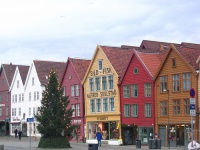
Bryggen
The site of the old medieval quarter of the city of Bergen, Bryggen is a charming, compact area of brightly coloured wooden homes that traditionally housed the city's merchants. Also called Tyskebryggen, its steep cobbled lanes are lined with a vivacious blend of cafes and artisans' workshops.
With many buildings dating from before the 17th century, The Hanseatic wharf area has been declared a UNESCO World Heritage Site and is considered to be one of the most important examples of a medieval settlement in the world.
Bryggen was once the working area of the merchants and is the oldest part of Bergen, characterised by a maze of lopsided wooden buildings with pointed gables facing the harbour. The Bryggen and Hanseatic Museums, as well as the 12th-century St Mary's Church, are all in the Bryggen area.
At one end of the wharf is Bergen's famous fish market, a colourful market also selling flowers, fruit, vegetables, and souvenirs. Because of its predominantly wooden buildings, Bryggen has struggled with fire throughout its long history and many of the structures have been rebuilt several times. One of the unexpected advantages of the destruction caused by fire was the discovery of a wealth of runic inscriptions, now housed in the Bryggen Museum.
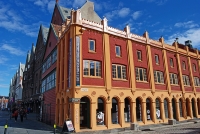
Hanseatic Museum
The Hanseatic Museum is housed in one of the oldest and best-preserved wooden buildings in Bryggen, the former home of a wealthy merchant. Furnished in the 18th century style, it provides a glimpse of the working and living conditions of the Hanseatic merchants during the Middle Ages.
The austere layout and maze-like rooms are saturated by the smell of fish and leave a lasting impression. Although a number of historic houses remain in the medieval district, the Hanseatic Museum is the only house left in Bryggen that has retained its original interior.
A short walk away next to St Mary's Church is the Schotstuene, a museum consisting of three assembly rooms and a kitchen once used by the Hanseatic merchants. Cooking was conducted in the Schotstuene as it was the only place in Bryggen where it was permitted to use fire. As a precaution, it was kept removed from the other buildings.
The ticket price for the Hanseatic Museum includes entry to the Schotstuene on the same day. The Hanseatic Museum is best visited on the guided walking tour, which begins at the Bryggens Museum. For many travellers, the Hanseatic Museum is one of the best historic attractions in the city and if you only visit one museum in Bryggen, it should probably be this one.
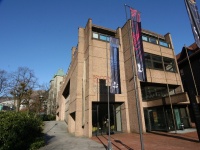
Bryggens Museum
This fantastic archaeological museum was built around the remains of the oldest buildings discovered in Bergen, dating from the 12th century, and the ruins have been incorporated into the exhibits along with excavated tools, ceramics, and even skeletons.
In 1955, parts of historic Bryggen were destroyed by fire and the subsequent excavations revealed some fascinating objects now on display in the museum. Bryggens Museum houses various artefacts and traditional costumes and imaginatively attempts to recreate life in the Middle Ages with displays of domestic implements, handicrafts, runic inscriptions, and items relating to seafaring and trade during medieval times.
The Bryggens Museum is the starting point for a wonderful historical walking tour through the UNESCO-listed district. This tour is really good value for money as it includes entry to two other museums as well. The guided tours are offered in several languages and depart every hour or so, depending on demand. The Bryggens Museum also houses temporary art and history exhibitions. The museum itself doesn't require much time to explore and is best seen as part of a wider exploration of the historic area.
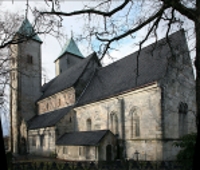
St Mary's Church (Mariakirken)
Bergen's oldest surviving building, the beautiful stone Church of St Mary's, dates from the 12th century. The interior is decorated with old frescoes and a splendid Baroque pulpit donated by the Hanseatic merchants in 1676.
The twin towers of the church are distinctive among the low red-tiled roofs of the old quarter. St Mary's is constructed mainly of soapstone and the architectural style is predominantly Romanesque.
The Church of St Mary's is the only one surviving of 12 churches and three monasteries built around the time of Bergen's foundation. Its survival is mainly due to the fact that it was the chosen place of worship for the wealthy German merchants of Bergen, whose patronage ensured it never fell into ruin.
Like many buildings in Bergen, St Mary's has been damaged by several fires through the centuries and has therefore been repaired and renovated. But even considering these slight alterations, the structure remains remarkably intact and has ultimately changed very little through the ages.
The church is an active place of worship and those wanting to attend services will find them listed on the website below. Sightseeing visitors are also welcome.
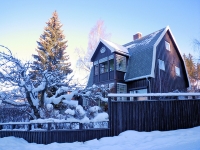
Lillehammer
Lillehammer is best known for hosting the 1994 Winter Olympics and the area does offer excellent opportunities for winter sports such as skiing and snowboarding. In fact, Lillehammer is considered Norway's oldest winter sports resort.
Lillehammer is picturesque, overlooking Lake Myosa and surrounded by mountains. The village transforms from season to season: a beautiful frozen world in winter and a lush green valley in summer.
In the cold, snowy months, visitors can find some of the best cross-country ski trails in northern Europe at nearby Nordseter and Sjusjoen, and a great ski centre at Hafjell. Lillehammer itself is a very small ski resort, with only about 630 feet (192 metres) of vertical descent and wonderful hiking opportunities in the summer months.
This small town has other attractions too, including Maihaugen, the largest open-air museum in Norway; the 12th-century Garmo Stave Church; and the PS Skibladner paddle steamer. The picturesque main street of Lillehammer is not to be forgotten, lined with charming 19th-century wooden houses. There is a wide selection of shops, restaurants, and accommodation in Lillehammer.
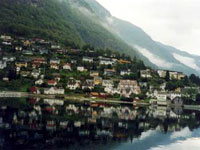
Sognefjord
Sognefjord is the largest fjord in Norway and the second longest in the world, stretching 127 miles (205km) from the coast to the village of Skjolden. Sheer cliffs rise to heights of 3,300 feet (1,000m) and more above the water.
In addition to some of the most dramatic and magnificent scenery in the world, Sognefjord contains or provides access to many of Norway's most famous tourist attractions. These include three popular national parks, two UNESCO World Heritage Sites, and much more.
Sognefjord offers once-in-a-lifetime experiences for visitors: travellers can see, touch and even walk on one of the largest glaciers in Europe in the Jostedalsbreen National Park; investigate numerous heritage treasures, like the UNESCO-listed Urnes Stave Church in Luster, the oldest church in Norway; marvel at the thundering waterfalls, wild rivers and pristine mountain lakes that feed into the fjord; and explore the steep mountains on either side of Sognefjord, which boast an impressive network of hiking, climbing and skiing trails.
Gorgeous, mostly dry summers and mild winters mean that the fjord can be explored at any time of year, depending on desired activities and adventures. Popular activities in and around Sognefjord include cycling, fishing, hunting, hiking, climbing, kayaking, river rafting, skiing, and canyoning. But those who just want to sit back and enjoy the splendid scenery can take one of the many fjord cruises or even enjoy a train trip.
Getting Around
Bergen has an efficient bus and night bus network, though service to the city's outskirts can be erratic. A free bus service operates during the day from Monday to Saturday, looping around the city centre.
However, central Bergen is easy to negotiate on foot, with plenty of attractions within walking distance. Metered taxis are plentiful and can be hailed at one of the many taxi ranks or ordered by phone, but are expensive.
The city also has an extensive ferry system, which tends to be less tourist-orientated than the express catamaran service, and visitors can enjoy spectacular views of the fjords. Driving in Bergen can be somewhat confusing, and drivers must pay a toll every time they enter the city so it becomes expensive. Nevertheless, car rental agencies are available.
Bergen Climate and Weather
Bergen is the warmest and wettest city in Norway. Summers are pleasantly mild to warm and in winter temperatures generally remain above freezing, although stiff breezes may make it feel much colder.
Snow falls on odd days and is generally not more than 10cm deep. In summer, June to August, average temperatures range between 50°F (10°C) lows and 64°F (18°C) highs; and in winter, December to February, average temperatures range between 31°F (-0.5°C) lows and 39°F (4°C).
The best time to holiday in Bergen depends hugely on your desired activities, as many people plan cruises and outdoor excursions that are weather dependent. The most popular time to visit Bergen is in late spring or early summer, May and June, when the city receives the most sun and its best weather.
Norway travel info
Electricity
Electrical current is 230 volts, 50Hz. Round two-pin plugs are in use.
Language
Norwegian and Sami are the official languages, but English is widely understood.
Money
The official currency is the Norwegian Krone (NOK), divided into 100 ore. Credits are accepted for almost all transactions, with Eurocard/Mastercard, Visa, American Express and Diners Club being the most common. Foreign currency can be exchanged at banks and major post offices, as well as many hotels and travel agents, although for poorer rates. ATMs are available in all towns and cities.
Tipping
Norwegians generally earn good salaries and, while it's perfectly all right to tip, a tipping culture doesn't really exist in the country. But customers do usually round up bills to the nearest 10 or 100 NOK.
Health
There are no real health risks associated with travel to Norway and the standard of healthcare is high throughout the country. A reciprocal agreement exists between the UK and Norway under which British nationals are covered for emergency treatment while visiting Norway as long as they hold a European Health Insurance Card (EHIC). Travellers should ensure that they have adequate travel and medical insurance.
Safety
Norway is a safe country in which to travel. However, travellers should still take sensible precautions to avoid petty theft, as they would anywhere in the world. Petty theft is most common at airports and bus and train stations in Oslo.
Local customs
Smoking is prohibited in all public places and on public transport in Norway, unless otherwise indicated. Norwegians tend to see everyone as being equal; they do not flaunt their wealth or financial achievements and frown on those who do. Travellers should note that whale meat is available legally in Norway, but that it is illegal to bring it into most other countries.
Doing business
Business in Norway is conducted formally, with an emphasis on punctuality and direct communication. Business attire is usually smart and fashionable, though not ostentatious. Titles and surnames are predominantly used on introduction, but may be dropped later, and greetings are usually made with a handshake.
Business cards are commonly exchanged. Expect business to be conducted in a direct and forthright manner, with little small talk or socialising. It is worth bearing in mind that Norway is an expensive country and that any services from lawyers, consultants etc. are subject to hefty VAT charges.
Business hours take place between 6am to 6pm, Monday to Friday. Norwegians highly value family and believe in a healthy balance between work and leisure. They are hardworking but overtime is frowned upon and workers in Norway are entitled to more leave than foreigners may be used to.
Duty free
Norwegian residents over 18 years who have been abroad for 24 hours or more don't have to pay duty on goods worth up to NOK 6,000. This includes up to 200 cigarettes or 250g of tobacco products.
The amount of alcohol depends on the purchase of tobacco. In addition to tobacco, one can declare 5 litres of beer or 2 litres of beer with 3 litres of wine or 1 litre of spirits, 1.5 litres of wine, and 2 litres of beer.
Without tobacco, one may include 1 litre of spirits, 3 litres of wine, and 2 litres of beer, or 4.5 litres of wine and 2 litres of beer. The last option is having 6.5 litres of beer only. Travellers arriving from outside of the EU should confirm their duty free allowance prior to arrival in Norway.
Communications
The international access code for Norway is +47. Hotels, cafes and restaurants offering free wifi are widely available. As international roaming costs can be high, purchasing a local prepaid SIM card can be a cheaper option.
Passport & Visa
All visitors to Norway must have sufficient funds, return or onward tickets and all documents needed for further travel. Passports should be valid for at least three months beyond the period of intended stay. Some European countries require only their National Identity Card if coming as a tourist to Norway. The borderless region known as the Schengen area includes the following countries: Austria, Belgium, Czech Republic, Denmark, Estonia, Finland, France, Germany, Greece, Hungary, Iceland, Italy, Latvia, Liechtenstein, Lithuania, Luxembourg, Malta, The Netherlands, Norway, Poland, Portugal, Slovakia, Slovenia, Spain, Sweden and Switzerland. All these countries issue a standard Schengen visa that has a multiple entry option that allows the holder to travel freely within the borders of all. It is highly recommended that passports have at least six months' validity remaining after your intended date of departure from your travel destination. Immigration officials often apply different rules to those stated by travel agents and official sources.
Entry requirements
United States citizens require a passport valid for three months beyond period of intended stay, but no visa is needed for stays of up to 90 days within a 180-day period.
British citizens require a passport valid for three months beyond period of intended stay, but no visa is needed for stays of up to 90 days within a 180-day period.
Canadians require a passport valid for three months beyond period of intended stay, but no visa is needed for stays of up to 90 days within a 180-day period.
Australians require a passport valid for three months beyond period of intended stay, but no visa is needed for stays of up to 90 days within a 180-day period.
South Africans require a passport valid for at least three months beyond period of intended stay. Holders of temporary passports are not allowed. A visa is required for travel to Norway.
Irish nationals must have a valid passport but no visa is required.
New Zealand citizens require a passport valid for three months beyond period of intended stay, but no visa is needed for stays of up to 90 days within a 180-day period.
Useful contacts
Oslo Visitor Centre: +47 23 10 62 00 or www.visitnorway.com
112 (Police); 113 (Ambulance); 110 (Fire).Embassies / consulates in other countries
Royal Norwegian Embassy, Washington DC, United States: +1 202 333 6000.
Royal Norwegian Embassy, London, United Kingdom: +44 (0)20 7591 5500.
Royal Norwegian Embassy, Ottawa, Canada: +1 613 238 6571.
Royal Norwegian Embassy, Canberra, Australia (also responsible for New Zealand): +61 (0)2 6270 5700.
Royal Norwegian Embassy, Pretoria, South Africa: +27 (0)12 364 3700.
Royal Norwegian Embassy, Dublin, Ireland: +353 (0)1 662 1800.
Embassies / consulates in Norway
United States Embassy, Oslo: +47 21 30 85 40.
British Embassy, Oslo: +47 2313 2700.
Canadian Embassy, Oslo: +47 2299 5300.
Australian Consulate, Oslo: +45 7026 3676.
South African Embassy, Oslo: +47 2327 3220.
Irish Embassy, Oslo: +47 2201 7200.
New Zealand Honorary Consulate General, Oslo: +47 923 01 701.



